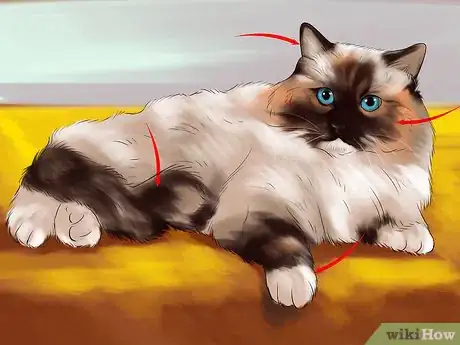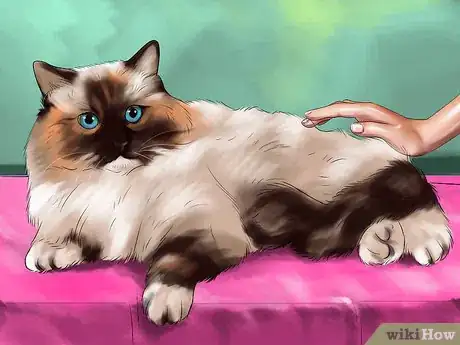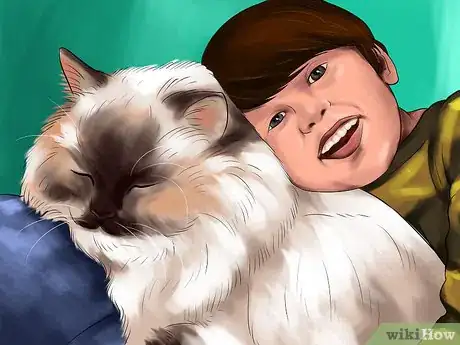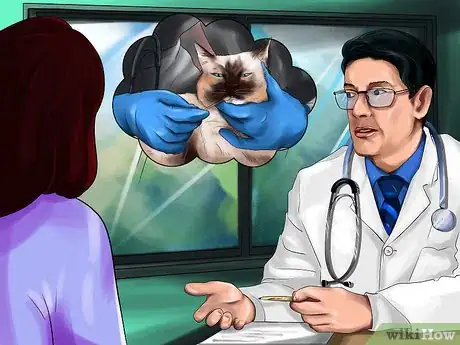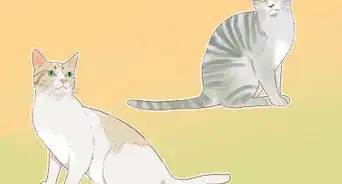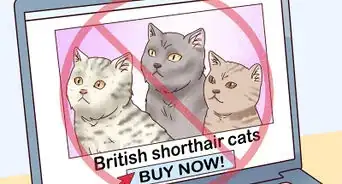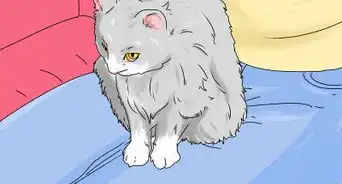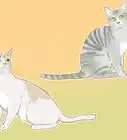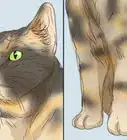This article was co-authored by Melissa Nelson, DVM, PhD. Dr. Nelson is a Veterinarian who specializes in Companion and Large Animal Medicine in Minnesota, where she has over 18 years of experience as a veterinarian in a rural clinic. She received her Doctor of Veterinary Medicine from the University of Minnesota in 1998.
There are 10 references cited in this article, which can be found at the bottom of the page.
This article has been viewed 93,810 times.
Ragdoll cats are beautiful animals who make great companions. Their soft coat and bright blue eyes add to their striking features, while their docile personality makes them a great addition to any family, even one with young children or other pets. Despite their large size, they are true lap cats who enjoy cuddling with their owners. Charming and affectionate, they don’t reach full adult maturity until around three years of age.
Steps
Noticing Physical Characteristics
-
1Look for blue eyes. According to the breed standards for Ragdoll cats, all examples of this breed must have bright blue eyes. If you see a cat without blue eyes, it is not a true Ragdoll cat.[1]
- Some breeders advertise non-blue-eyed variations of the Ragdoll breed. However, this variant is not accepted by any major Ragdoll association and isn’t included in the written Breed Standard for Ragdoll cats.
-
2Identify the pointed coloring. Ragdoll cats can come in a variety of colors and patterns; however, the accepted breed standard establishes that these cats must exhibit the pointed breed characteristics to be included. This means that the cat’s body will be lighter in color than the points of its body – the face, ears, tail, and legs.[2]
- Ragdolls come in four main patterns: bi-color, van, mitted, and colorpoint. These patterns also appear in six major colors – seal, blue, chocolate, lilac, red, and cream – while the points can be solid, lynx, tortie, or torbie.
- Colorpoint ragdolls have the classic “pointed” markings and no white anywhere in their coat.
- Mitted Ragdolls have white feet in the front, white boots all the way up and around the hocks in the back, a white chin, and belly stripe. Mitted Ragdolls may also have a blaze, star, or hourglass patch of white on their forehead and nose.
- Bi-colors usually have more white – their paws, underbodies, chest, and an upside-down ‘V’ marking on their faces are white. Only their tails, ears, and the outer part of their masks show the darker markings.
- In the Van pattern, only the top of the mask, ears, and tail, and perhaps a few spots on the body, show darker markings.
Advertisement -
3Notice the size of the cat. Ragdoll cats are typically quite large cats when compared to other breeds. They aren’t necessarily overweight cats (though they are often prone to overeating and gaining a larger belly); even the fittest Ragdoll cats are large in size and shape.[3]
- Adult male Ragdolls usually weigh around 15 to 20 pounds, while adult females typically weigh 10-15 pounds.
-
4Check the texture of the coat. Despite the fluffy, luxurious coat most Ragdoll cats have, they actually don’t shed very much. Their fur is medium long and requires very little grooming.[4]
- Because of the soft nature of the Ragdoll’s coat, what shedding does occur is quite easy to clean up, as it typically just sits on the surface of fabrics rather than working its way into the material.
- During shedding season, it is possible for Ragdoll fur to become a bit matted under the armpits.
Identifying Personality Traits
-
1Notice the cat’s docile personality. Ragdoll cats are calm and easy to get along with. They enjoy playing interactive games with their owners – like fetch and following their owners around the house – but generally avoid the wild, destructive behavior other breeds often engage in.[5]
- If your cat seems like a hyperactive kitten all the time, it probably is not a member of the Ragdoll breed.
-
2Check if the cat gets along well with children and other animals. Most Ragdoll cats are very calm and easily adapt to households with children and other animals. Due to their docile nature, Ragdolls can quite easily integrate into new situations, especially if they are raised around young children or other pets from the beginning.[6]
- It is not uncommon for children to “lug” their Ragdoll friend around the house. This breed tolerates this kind of treatment very well.
-
3See if the cat is affectionate. Ragdoll cats are known for being very affectionate and cuddly. They are lap cats who enjoy being held and spend much of their time napping on or near their owners. Ragdolls are notorious for going slightly limp when being picked up (hence the name Ragdoll), and even love being cradled on their backs like a baby.[7]
- Ragdoll cats typically prefer the company of their owners and will seek them out most of the time. Your Ragdoll cat will want to be near you.
Seeking Professional Advice
-
1Consult a reputable breeder. If you want to be sure that your cat is a Ragdoll cat, try to work with reputable breeders who are supported by the Ragdoll cat community. There are plenty of associations dedicated to the love and care of Ragdoll cats, and these groups can recommend reputable breeders to you.[8]
- Try the Ragdoll Fanciers Club International, Ragdoll Kittens, or Rock Creek Ranch Ragdoll Cattery.[9]
-
2Check for documentation. Most reputable Ragdoll breeders will have documentation that certifies them as members of reputable Ragdoll breeder associations. These forms authorize them to breed and sell acknowledged Ragdoll cats and kittens.
- They should also be able to provide you with a certificate of authenticity regarding your Ragdoll cat.
-
3Ask your veterinarian. If you are still wondering whether or not your cat is a member of the Ragdoll breed, you should contact your veterinarian and ask for advice. Your vet can help you assess the cat’s features and characteristics and determine the cat’s breed based on their expert knowledge.[10]
- Your vet may even be able to perform a DNA test on your cat to determine its breed.
References
- ↑ http://www.vetstreet.com/cats/ragdoll
- ↑ http://cfa.org/Breeds/BreedsKthruR/Ragdoll.aspx
- ↑ http://www.animalplanet.com/tv-shows/cats-101/videos/ragdoll/
- ↑ http://www.rfci.org/info/description.php
- ↑ https://www.petfinder.com/cat-breeds/ragdoll
- ↑ http://www.petmd.com/cat/breeds/c_ct_ragdoll
- ↑ http://cattime.com/cat-breeds/ragdoll-cats
- ↑ http://www.rfci.org/
- ↑ http://rockcreekranchragdolls.com/
About This Article
To identify a ragdoll cat, check to see if the cat has blue eyes, since all ragdoll cats have them. Additionally, see if it's body is lighter in color than its face, legs, and tail, as this is another key feature of ragdoll cats. You should also consider the cat's size since ragdoll cats tend to be larger than most cats. than most other cats. Alternatively, you'll be able to identify a ragdoll cat by its docile personality, as it enjoys playing interactive games but usually remains calm. For tips on how to find a reputable ragdoll breeder, keep reading!

